
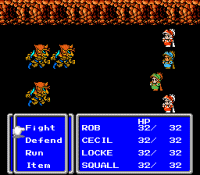
| |
Square's last outing for the NES, they pushed the 8-bit
system to its limits.
|
It was another two years before the third Final Fantasy
game appeared, and by this time it was one of the most
eagerly anticipated releases of its time. Final Fantasy III, released
in Japan in 1990, was the last game in the series to appear on the
NES, a system that was beginning to look dated in the face
of a new wave of 16-bit consoles. None-the-less, it was another
excellent title, and very well received among fans.
The nearest thing to a true sequel in the Final Fantasy series,
Final Fantasy III shared many elements with the original game. The
plot concerned an ancient evil, long-contained but now seeking to
escape its bonds with and lay waste to the world. Once more, only
four Light Warriors of legend could defeat this dark force and
restore balance to the world. The game began with four young
orphans exploring a mysterious cave. Once inside, they were
attacked by beasts, and forced to fight their way through. Eventually,
in a crystalline chamber, they discovered the lost Wind Crystal, which
explained the danger facing the world. Proclaimed them to be
the 'chosen ones', the Crystal granted each of the four a special power,
and sent them on a quest to destroy the malignant force threatening
their world.
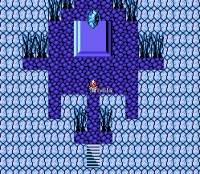
|
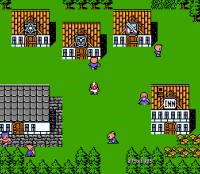
| |
Moogles made their first appearance...
|
... but still never released to western audiences; Final Fantasy by this
time had become a household name in Japan.
|
Final Fantasy III was a 4Mb NES cartridge, and Square put the extra
capacity to great use. As well as pushing the humble NES to its graphical
and sonic limits, the third Final Fantasy game was also far more
complex and detailed than earlier offerings. The system was similar
to that of the original, enabling players to choose the names and character
classes for four heroes. This time, however, there were more classes,
and the game featured more locations, monsters, weapons, equipment and
spells.
Amongst these were several new additions that have since become
trademarks of the Final Fantasy line. Chocobos were back, and this
time there were two different kinds. The cutesy Moogles made their
first appearance, together with several more
monsters and weapons that are now standard features. Final Fantasy III
also introduced several new classes, including the Dragoon and the Caller,
together with a new set of summoning spells. Although their names were
different, these spells are still recognisable as the same ones that
appeared in Final Fantasy VII - Chocobo, Shiva, Ramuh, Ifrit and the
rest.
Despite its impressive sales in Japan, Final Fantasy III never appeared
outside its home country.
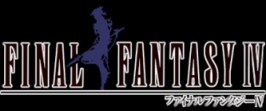
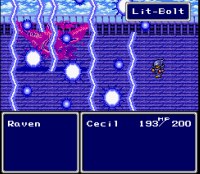
| |
A surprise success in the US, but nowhere near as in
Japan...
|
By 1991, Square had gone from being just another small
games company to one of the most respected software
houses in Japan. The Final Fantasy series had already
become one of the most popular games lines in the
country, and the release of the original Final Fantasy
in America in the previous year had begun to pave the way
for the international fame that was to follow. Perhaps the
most important step the company ever made, though - at least
until the release of Final Fantasy VII on the PlayStation -
was with Final Fantasy IV.
The fourth game in the series was the first role-playing
game to be released on Nintendo's new console, the Super
Famicom (known to us as the SNES). A 16-bit machine with
an impressive array of custom graphics and sound chips, the
SNES was a gorgeous piece of kit at the time, and the Japanese
gaming world was eager to see what Square would do with the
machine's greater power. They certainly weren't disappointed.
Final Fantasy IV was an 8Mb SNES cartridge, and it put the
vastly more impressive graphics and sound of the SNES to good
use. The characters and monsters were larger, more colourful
and much more detailed than before; the look of the game's
magic was improved, and the summon spells were awesome.
The extra capacity of the SNES cartridge, and the machine's
greater processing speed and memory, were stretched to
provide gamers with one of the most complex, engrossing
and imaginative storylines ever to appear in a videogame.
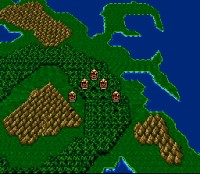
|

| |
Final Fantasy IV was the first Final Fantasy to truely impress players
with graphics and sound...
|
...something that was to become a feature of the series from herein.
|
Final Fantasy IV returned to the 'fixed' character
concept first used by Square in Final Fantasy II, casting
the player as Cecil, a Dark Knight and captain of the
Red Wings (an elite force of military airships in the
Kingdom of Baron). As the game began, though, Cecil
questioned the desire of his king to capture the Elemental
Crystals, and was sent to deliver a strange package
to a nearby town. When the package exploded, destroying the
town and nearly killing him, Cecil and his friend Kain
vowed to fight against the King's power-mad ambitions.
As the pair made their way through the game, they
befriended nine other characters.
After its massive success in Japan it was
unsurprising that Final Fantasy IV was translated
into English and released in America, where it
enjoyed more healthy sales and critical acclaim. However,
due to the fact that Final Fantasy II and III hadn't been
released in the States, the game was renamed Final Fantasy II,
beginning a tricky number policy that was only
stopped when Square released Final Fantasy VII... well, Final Fantasy VIII.
There were two versions of Final Fantasy IV released in Japan - the
'standard' game, and Final Fantasy IV Easytype. Easytype was
intended for younger players, and had many items, monsters,
spells and skills removed. It was also the version which
the American Final Fantasy II was based, so there's never
been a true (official) English-language edition of the complete
Final Fantasy IV.


|

